Day 1 : Namib Desert Lodge
After breakfast and meeting your guide for the safari you will depart for Sossusvlei. We will drive through the Khomas Hochland and down the escarpment via one of the scenic mountain passes into the Namib Desert. This journey will take about 4 hours depending on the number of stops for photographs. After lunch and settling in at the lodge we will depart for a late afternoon scenic nature drive or an excursion to Sesriem Canyon. Dinner and accommodation will be at one of the best lodges in the area perfectly situated to explore the surrounding desert and its attractions.
The Namib is the oldest desert and boasts the highest sand dunes in the world. This region is one of the most spectacular areas of Namibia and always one of the highlights of any safari. The name Sossusvlei refers to the vlei or pan into which the seasonal Tsauchab River flows in years of exceptional rainfall. The neighbouring Dead Vlei with the ancient dead Camel Thorn trees is one of the most photographic sites in good early morning light. The Sesriem canyon is a narrow gorge about 1 km long and is well worth a visit. Several desert adapted wildlife like oryx, springbok, black-backed jackal, ostrich, sociable weavers and plenty of reptiles and small
The Namib is the world’s oldest desert, and although it stretches along the entire length of Namibia’s coastline, the Namib commonly refers to the vast sea of sand from Luderitz to Swakopmund. For a big sandy desert, the scenery is remarkably varied, with the giant red dunes of Sossusvlei being the most famous part. Because of how old it is the Namib is home to numerous species that don’t occur elsewhere and although no humans live in the desert an amazing array of flora and fauna manages to survive here. Famous species include the Welwitschia – a living fossil plant, endemic chameleons, fur seals along the coast, brown hyenas, jackals and remarkably one of Africa’s largest antelope the Gemsbok. The name Namib is of Nama origin and means “vast place” and vast it certainly is.
The main building and the chalets of Namib Desert Lodge are spread out along the foot of the fossilised dunes of the ancient Namib. A comfortable sojourn is guaranteed by 65 en suite rooms with air conditioning. A restaurant and bar, an inviting terrace with views of the fossilised dunes and two swimming pools beckon you to linger and relax.
Oryx antelope and springbok make frequent appearances at this illuminated watering place.
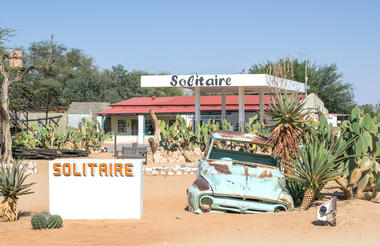
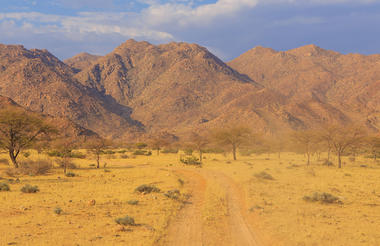
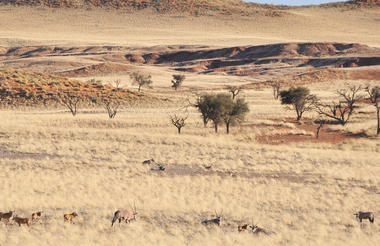
Day 2 – 4 : Swakopmund Sands Hotel
After an early breakfast and coffee we will depart for a morning excursion to Sossusvlei and Dead Vlei. We will stop at the scenic Dune 45 along the way and spend a couple of hours at both Sossusvlei and Dead Vlei. Some of the dunes in the area are a few hundred meters high but the view from the top for those that dare is one you will never forget. After lunch we will depart for Swakopmund via the Namib Naukluft National Park. We will spend the night at a guesthouse and have dinner at one of the top restaurants in Swakopmund. Please note that dinner tonight is not included and for your own account.
Swakopmund is a very popular holiday destination for many Namibians and will probably be the only place that you will visit on the Namibian safari that has a real town feel to it. Wedged between the Namib Desert and the cold Atlantic Ocean, Swakopmund which is known for its very relaxed atmosphere, has something for everybody. There are plenty of great restaurants and bars, good shopping opportunities and fascinating architecture. For the adventurous there’s quad biking, sand-boarding, skydiving, beach angling and scenic flights over the coastline and Sossusvlei to name a few. The nearby Walvis Bay, Namibia’s major harbor town is well known for the lagoon and its prolific bird life.
Founded in 1892 as the main harbour for German South West Africa, Swakopmund is often described as being more German than Germany. Now a seaside resort, Swakopmund is the capital of the Skeleton Coast tourism area and has plenty to keep visitors happy. The quirky mix of German and Namibian influences, colonial-era buildings and the cool sea breeze make it very popular.
Activities include exploring Dune 45 and Sossusvlei – The Vlei.
Dune 45 is named for its location 45 kilometres past the town of Sesriem, Dune 45 is renowned for its elegant shape, which – along with its position close to the road – have earned it the distinction of ‘most photographed dune in the world’. If you’re not keen for the strenuous hike to the top of Big Daddy, Dune 45 is a more forgiving alternative, standing at only 80 metres and featuring a much gentler gradient.
Sossusvlei – The Vlei is the vlei itself where, for now, the waters of the Tsauchab River disappear into the red sands of the Namib.
The Swakopmund Sands is literary minutes’ walk away from the very popular Jetty and TUG restaurants as well as other tourist attractions and yet you have total privacy once on the premises of the Hotel. Each room is equipped with a flat screen TV, safe, under floor heating, fridge, as well as tea and coffee facilities for your convenience. A laundry service is available for same day delivery.
Each bathroom has a hairdryer and shaving facilities and all international power points can be used. In the morning you will be able to enjoy a sumptuous buffet breakfast in a very relaxing and tranquil dining area.
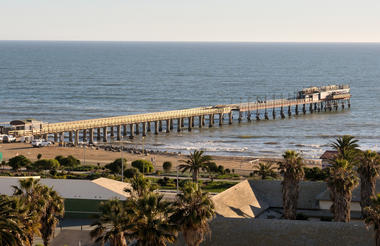
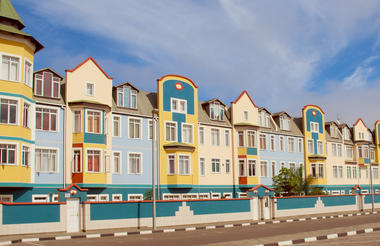
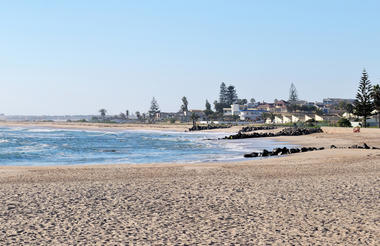
After breakfast on day 3 we will depart for a living desert adventure where we will encounter and learn more about the fascinating wildlife of the Namib Desert. We will look for gecko’s, scorpions, side-winder snakes, lizards and beetles as well as the incredible plant life that survives in this harsh environment.
Once we are back in Swakopmund we enjoy lunch and then have the afternoon available to explore the town or perhaps finish the day with a quad-biking and dune-boarding adventure. Other optional activities that could be arranged include scenic flights over the coast and dunes.
Activities can include the Living Desert Tours, which is a unique 4×4 adventure which specializes in bringing the desert to life while sharing the awesome beauty of the Namib Desert with travellers from all over the world. The coastal dune belt may seem barren and lifeless to many people, but in fact it is alive with a fascinating variety of little desert adapted animals, which are able to survive on the life-giving fog which consistently rolls in from the cold Atlantic Ocean.
Come see the Dancing White Lady Spider (Carparachne aureoflava) cartwheel 44 turns per second down a dune to escape the enemy. Admire the transparent Namib Dune Gecko (Pachydactylus rangei) with webbed feet that are equivalent to snow shoes. Learn about the different beetles and insects and how they survive in the dune desert. Follow in the tracks of a legless Lizard (Fitsimmon’s Burrowing Skink), observe Sand Diving Lizards (Meroles Anchieta) dancing on the hot sand, Sidewinder Snakes (Perinquey’s Adder), Desert Chameleons and many more fascinating creatures. Learn about the geology, structure and formation of the desert, and admire the vast and beautiful landscapes while enjoying a scenic dune drive combined with fun and adrenalin.
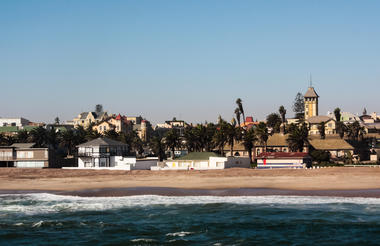
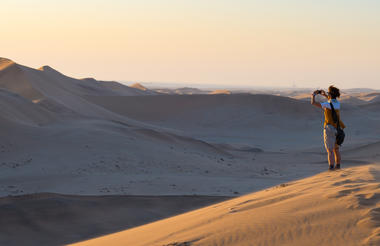
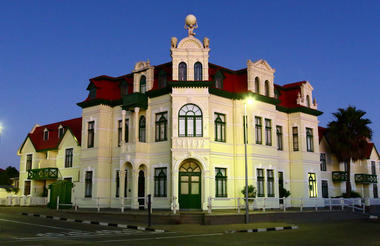
Day 4 : Twyfelfontein Country Lodge
Then we continue our safari northwards along the Skeleton Coast. After visiting a shipwreck and the massive Cape Fur Seal colony at Cape Cross Seal Reserve we will turn inland towards Damaraland. We will drive past the Brandberg, Namibia’s highest mountain with the highest peak at 2573 meters. We will be at our lodge in time for a sun-downer drink while we enjoy the view over this beautiful landscape.
Set in the Kunene Region of north-western Namibia, Twyfelfontein is a spectacularly scenic area, featuring one of the largest and most important concentrations of rock art in Africa. The name ‘Twyfelfontein’ translates to ‘Fountain of Doubt’, which refers to the perennial spring situated in the impressive Huab valley flanked by the slopes of a sandstone table mountain. It was this spring that attracted Stone Age hunters over six thousand years ago, and it was during this time that the extensive group of rock engravings and paintings were produced. Visitors can look forward to basing themselves at some wonderfully shady campsites along the Aba-Huab riverbed, while exploring over thirty different sites of these sacred records of ritual practices relating to traditional hunter-gatherer communities.
The Lodge is situated in the heart of the Twyfelfontein Uibasen Conservancy and boast 56 en-suite twin rooms, reception, lounge, curio shop, open dining room, bar and swimming pool. In construction utmost care was taken to reduce the visual impact on the environment and to blend into the mountainside with the use of thatch roofs, natural stone and paint colours toning in with the surrounding rock formations.
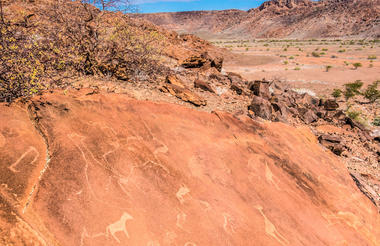
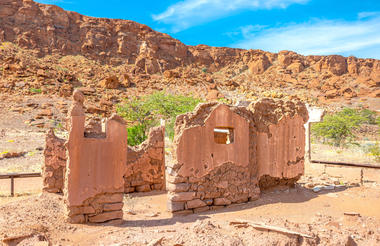
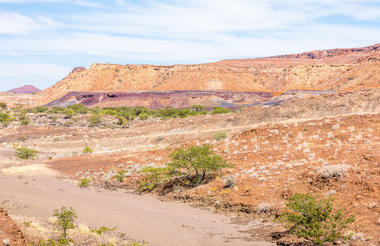
Day 5 – 7 : Etosha Safari Lodge
After breakfast we will visit the Twyfelfontein rock engravings (Namibia’s only world heritage site), burnt mountain and organ pipes rock formation and the Petrified Forest en route to Etosha National Park where will spend the next 3 nights. Etosha is one of Africa’s biggest and best National Parks and one of the main tourist attractions in Namibia. It is 22 912 km 2 in size of which the Etosha Pan, a shallow depression that only holds water after good rainy seasons, is 5000 km 2 in size. Etosha is known for its spectacular game viewing and the waterholes attract huge numbers of game in the dry season when all the open water has dried up. During the rainy season the park is transformed into a green oasis and this is the time you find young of various animal species in huge numbers. 114 Species of mammal are found in the park and it is the best place in the world to see Black Rhino. Other game include elephant, lion, leopard, cheetah, hyena, giraffe, honey-badger, black-faced impala, kudu, eland, damara dik-dik, warthog and big herds of springbok, zebra, blue wildebeest, red hartebeest and oryx. More than 300 species of birds are found here and it is brilliant for finding raptors. We will do morning and afternoon games drives and relax at the pool or camp waterhole between drives.
The Etosha National Park is Namibia’s premiere game viewing experience, situated in the northwest of Namibia and is an area well known for its wildlife. Vegetation ranges from dense bush to open plains attracting a diversity of wildlife. In the heart of the Park is The Etosha Pan – a shallow depression that covers an area of 5000sq kilometres. Dry and shimmering for most of the year, the pans fill up with water after good rains to a depth which is seldom deeper than 1m. In the dry season wildlife is attracted to perennial springs and waterholes that makes for excellent game viewing.
Within the park are three large public rest camps catering for the more budget orientated traveller. There are several smaller establishments on the outskirts of the park on private land offering a more intimate and comprehensive experience. All of these establishments offer excellent value for money.
Activities can include the Twyfelfontein Rock Art, which is a World Heritage Site boasting one of the richest rock art concentrations in Africa. Thousands of tourists come to this site each year to view some 2, 500 Stone Age rock engravings. The area is home to 17 rock art sites, which collectively encompass 212 engraved stone slabs. There are an additional 13 sites displaying rock paintings.
Guests rave about the view: the restaurant and chalets, situated on a hillock, offer magnificent views of the African bush savannah. All of the 65 double room chalets have air conditioners and mosquito nets, and a choice of three swimming pools between them. Apart from the restaurant and bar there is a wooden platform for sundowners high above the Mopani bush. The Andersson Gate into Etosha National Park is a mere 9 km away. Those who do not want to drive themselves can join one of the lodge’s daily safari trips into the park.
A shuttle service operates between Windhoek and Etosha Safari Lodge and Camp (on request).
Included are entrance fees for the following: Twyfelfontein Rock Engravings Burnt Mountain; Organ pipes and Petrified Forest Etosha Park Fees.
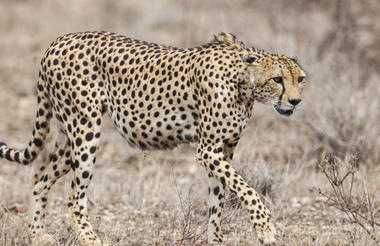

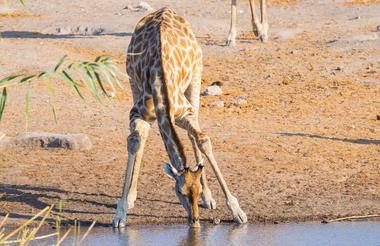
On day 6 we will do morning and afternoon games drives and relax at the pool or camp waterhole between drives.
The area and vegetation is very different to the south-eastern and eastern part of the park and the Hartmann’s Mountain Zebra can be found here. In this area and with a more undulating landscape, it makes for a very different wildlife experience. White dust and clay which makes up the Etosha Pan turns to a reddish-brown soil during this time which may lead you to believe you have entered an entirely new park when you visit.
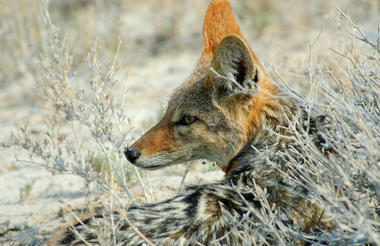
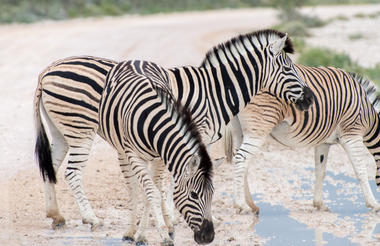
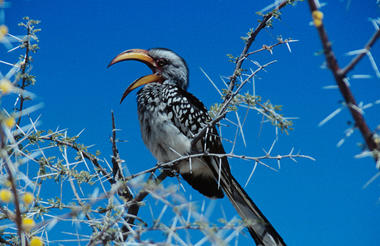
Day 7 : Mushara Lodge
From here we will make our way across the park in a full morning game drive to Mushara Lodge on the eastern boundary where we will spend the next night. I love this lodge and park of the park with excellent game viewing and am sure you will enjoy this as well.
Located only 8kms from the Von Lindequist Gate on the eastern outskirts of the Etosha National Park, Mushara Lodge is ideally situated for travellers visiting the park.
Our Lodge consists of ten spacious chalets, one family unit and two single rooms.
The name Mushara derives from the Purple Pod Terminalia tree, which grows in abundance in the lodge grounds and the surrounding area. The thatched public area consists of a small library with a selection of good books, a bar with an extensive wine cellar, airy lounge with welcoming fireplace for winter evenings, a dining area and well stocked curio shop.
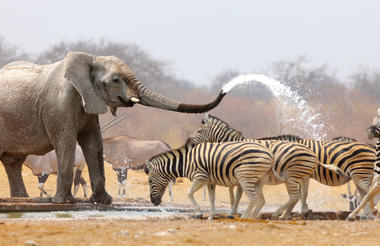
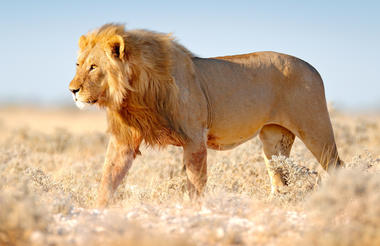
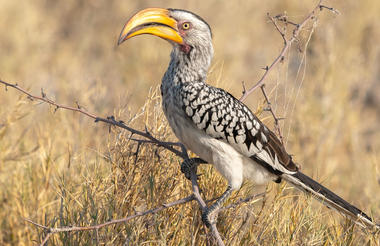
Day 8 : transit
After an early morning breakfast we will depart for Windhoek where you will catch your connecting flight.




